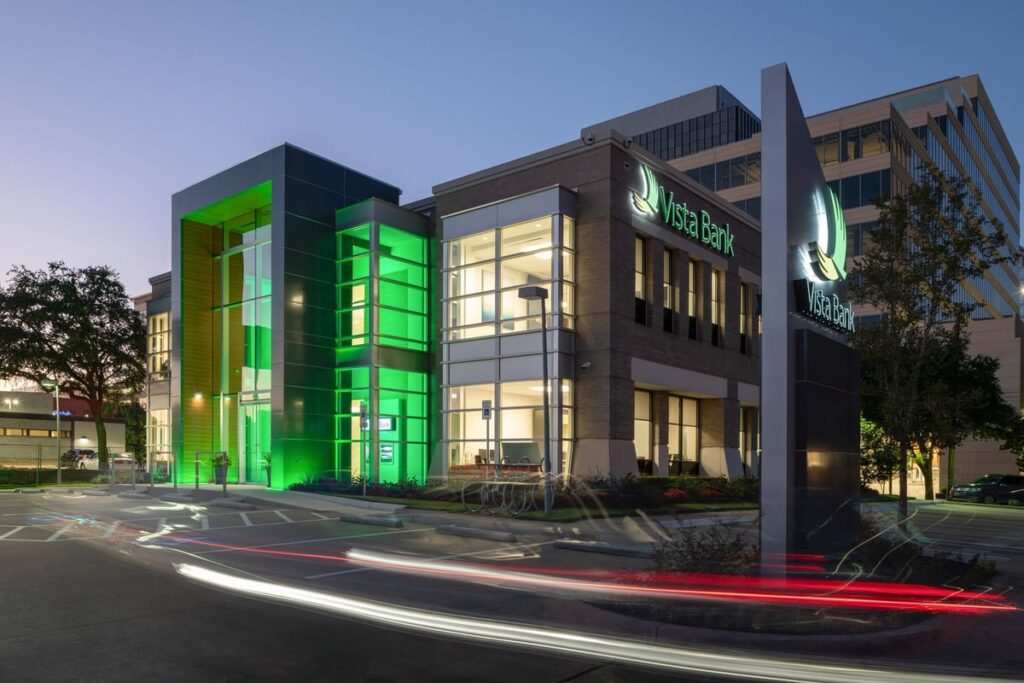Family-owned, century-old Vista Bank weathered Texas’ devastating Dust Bowl, endured a couple world wars and survived the bank-busting Great Recession.
Now, as a highly contagious virus infects the global economy, the 15-location community bank is taking on one of the biggest business loan programs ever launched in the U.S.
Vista is one of 15 lenders in Texas ready to hand out money through the Federal Reserve’s Main Street Lending Program, the midsize company complement to the more highly publicized small business-focused Paycheck Protection Program.
“I think we could do $1 billion in loans with this program,” said John D. Steinmetz, CEO of the 165-employee bank that moved its headquarters from the Texas Panhandle to Dallas last year.
Both the Main Street and PPP loan programs originated in the massive $2 trillion CARES Act in March. PPP doles out loans of up to $10 million for companies with 500 or fewer employees (One PPP loan from Vista was just $92). Main Street loans range from $250,000 to $300 million for companies with 15,000 or fewer employees.
With $600 billion available, the Main Street program trumps the original $349 billion that PPP dispensed in a matter of weeks. But it also took nearly twice as long to roll out and comes with repayment terms that aren’t as forgivable as the paycheck protection money.
Delayed rollout
The Main Street Lending Program didn’t go live until mid-June, around the time many states were allowing pandemic-closed businesses to reopen. The Fed and Treasury Department reportedly had to work through disagreements about the strictness of loan terms, with the Fed wanting more lax terms.
Joel Werkema, spokesman for the Federal Reserve Bank of Boston, which is acting as the program administrator, said Main Street lending is more complex than PPP. While the SBA approved each PPP loan, individual banks with different underwriting terms approve each Main Street loan.
“You could hire people to look at every loan and work with banks to underwrite them,” Werkema said. “But instead, we’re trying to do it in a fairly tech-savvy and fairly automated way. It’s a little bit akin to setting up a fintech institution in a few months, which we feel pretty good about.”

John D. Steinmetz is the first Vista Bank CEO who is not part of bank’s founding family, which has helped lead the bank for five generations.(Vista Bank)
Local bank, big loans
The Main Street program was met with a tepid response from lenders when it launched June 15. But not from Vista.
The 108-year-old institution isn’t turned off by the Main Street program’s requirement that banks take a 5% stake in each loan, something that likely scared off other lenders since they weren’t asked to do the same for PPP loans.
The 5% rule gives Vista a once-in-a-lifetime chance to approve individual loans that far exceed its typical lending limit of about $20 million, Steinmetz said. For the first time in its history, it can approve a $300 million loan, as 5% of that is $15 million, which is well within its loan limit.
“It’s allowing us to punch above our normal lending limit,” said Steinmetz, who became the bank’s first chief executive outside its founding family in 2015.
Four members of the founding McLaughlin family still sit on the bank’s board. But Vista is expanding well beyond its agricultural lending roots in Ralls — a city in Crosby County with a population of less than 2,000. It now has locations in Dallas, Fort Worth, Austin and Lubbock.
The small-town bank, which has grown to over $1 billion in assets and about $870 million in deposits, has been amazed at the size of its Main Street lending clients.
“It’s given us the opportunity to compete with big banks like Wells Fargo that are normally too large to compete with due to our legal lending limit,” Steinmetz said.

The 108-year-old Vista Bank started in Ralls with $11,000 and now has over $1 billion in assets and a new headquarters building in Dallas.(Kevin Brown)
The results aren’t in
The response from borrowers has been lukewarm, too, compared with the initial surge for PPP money.
Banks say that’s because PPP loans are forgivable if most of the money goes toward payroll, while Main Street loans must be paid back. The Fed can’t give away money like Congress, which approved PPP, Werkema said.
“The Main Street program is an effort to be as helpful as the Fed can be to ensure business credit continues to flow within the constraints of what it’s able to do by law,” he said.
Steinmetz said he’s seen a significant increase in interest in the past two weeks as more borrowers learn about the program.The more complex approval process can take up to 30 days, meaning it’s too early yet to deem it a success or failure.
Vista Bank has approved less than 10 loans but is in the process of underwriting 30. It expects to approve 100 loans before the program ends Sept. 30.
“I would compare the demand for [Main Street lending] to the second round of PPP loans in May,” Steinmetz said, referring to the additional $310 billion put into PPP after the initial fund ran dry. “The demand for the first round of PPP in April was just unprecedented.”
In contrast, Vista approved over 1,800 PPP loans through June 30, with over half in North Texas and about 75% of them being new clients. Banks will likely write fewer Main Street loans, but the average loan size will swamp those approved under PPP.
“Our average PPP loan to date was just under $90,000,” Steinmetz said. “That loan amount wouldn’t even qualify under [Main Street], where the minimum loan amount is $250,000.”
Vista Bank believes the Main Street program is still attractive to companies with more than 500 employees.
Click here for the full story.
